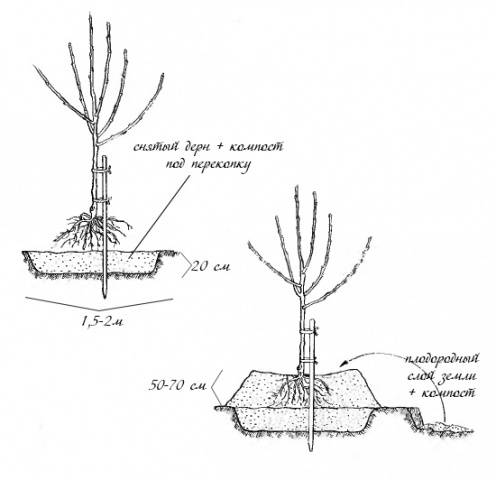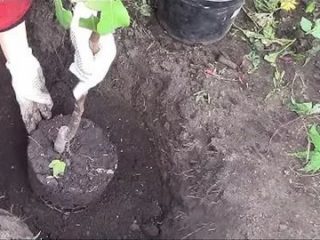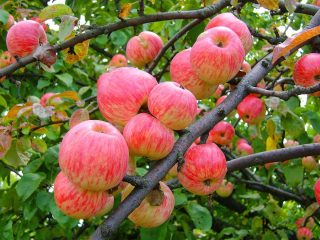Content
- 1 Features of the soil and climate of the Leningrad region
- 2 Choosing a planting date for an apple tree
- 3 Apple tree varieties zoned in the Leningrad region
- 4 Selection of seedlings
- 5 Subtleties of planting a seedling
- 6 How to plant bare-root apple trees
- 7 How to plant apple trees with a closed root system
- 8 Planting an apple tree in soil with a high clay content
Apple trees are trees without which it is impossible to imagine any garden. They are beautiful when they bloom. And at the time of pouring apples, the gardener’s soul is delighted, anticipating a harvest of healthy and tasty fruits. Apple trees are planted almost everywhere. The Leningrad region is no exception.
Features of the soil and climate of the Leningrad region
The Leningrad region belongs to the North-Western region. The proximity of the Atlantic affects the climate - it is humid, with frequent precipitation, most of which occurs in the summer. The Atlantic also affects the temperature regime, lowering summer temperatures and increasing winter temperatures. The proximity of the Arctic is affected by a sudden breakthrough of cold Arctic masses, which bring severe frosts in winter, and sharp cold snaps in summer, sometimes even to the point of frost.
The soils in the region are poor podzolic or peaty, often overly moist. The humus layer is thin.
Not every apple tree variety will survive in such conditions, especially if it is a young seedling. The timing of its planting is very important for survival.
Choosing a planting date for an apple tree
Sometimes the time for planting an apple tree is determined only by the time the seedling reaches the site. But this approach does not guarantee the survival of the apple tree. If you plan to plant an apple tree in the fall in the Leningrad region, you must wait until the end of the trees’ growing season and purchase seedlings that have already lost their leaves and entered a dormant state. Then, after planting, all the efforts of the apple tree will be directed to the development of the root system, which continues until the earth cools below plus 4 degrees. Such an apple tree seedling will most likely survive the winter safely and begin the growing season in early spring, without wasting time on establishment. But this is provided that the variety is zoned.
Apple tree varieties zoned in the Leningrad region
The apple tree variety must be chosen taking into account not only the climate, but also the type of soil, as well as the height of the groundwater. The gardener himself can improve the soil, but it is very difficult to deal with close groundwater levels.
But if you don’t have to limit yourself in your choice, you can plant apple trees with normal tree sizes.
Summer varieties
White filling
A well-known, but no less tasty variety with white fruits. Having hung on the tree until fully ripe, they become translucent, completely filled with juice. The apple tree is distinguished by enviable winter hardiness and begins to bear fruit in the sixth year. The fruits weigh up to 150 g in young trees, becoming slightly smaller as they mature. The shelf life is short - only a couple of weeks.
Memory of Lavrik
The variety was bred at the Leningrad Experimental Station and is similar in appearance to one of its parents, Papirovka, but much larger. Average weight is about 0.2 kg. The taste is excellent.
Among the summer varieties of apple trees, one can also note: Cinnamon Striped, Iulskoye Chernenko, Lungwort.
Autumn varieties
Melba
An old Canadian variety of apple tree, which is zoned throughout almost the entire territory of Russia. It is distinguished by high taste, large fruit size, and excellent winter hardiness. The ripening period, depending on the season, is late summer or early autumn. You can try the first apples already in the fourth year.
Delight
An apple tree variety with a “talking” name, selected by S. I. Isaev. It is classified as a semi-dwarf, and therefore has a compact size. A continuous blush with noticeable stripes on a yellow-green background, as well as the presence of white dots, make the apples very elegant. The taste is dessert. It produces the first apples in the fourth year, and bears fruit regularly. He practically does not suffer from scab, which is very important for the Leningrad region. Winter hardiness at a high level.
The following winter-hardy varieties of apple trees are very tasty and disease-resistant: Riga Dove, Baltika, Izbrannitsa, Aelita.
Winter varieties
Antonovka
A well-known ancient variety of apple tree with good winter hardiness and good taste of the fruit. Can be affected by scab, trees have considerable dimensions.
Gift to Grafsky
An excellent winter-hardy apple tree variety with large, 200 g or more, fruits of a beautiful purple-red color and good taste.I am pleased with the long shelf life - until April.
You can also plant apple trees of the Antey, Orlik, and Ladoga varieties.
For owners of small plots, there are columnar varieties of apple trees for which the climate of the Leningrad region is quite suitable: Vasyugan, President, Medok. These apple trees do not take up much space, and they can be planted even where the groundwater is high, but it is better on embankment ridges.
In order for the tree to take root well and subsequently delight you with fruits, you need to choose the right young apple tree.
Selection of seedlings
It happens that a gardener, after several years of waiting, having tasted the first fruits, is saddened to realize that what has grown is not at all what was planted. To prevent this from happening, buy apple tree seedlings only from trusted nurseries. Make sure the planting material is of good quality. When purchasing bare-rooted apple tree seedlings, inspect them carefully; it is especially important to check for the presence of small, light-colored roots. They are the ones who feed the apple tree.
As a rule, one-year or, at most, two-year-old apple tree seedlings have the greatest chance of taking root; in older trees, when dug out of the soil, the root system is too damaged, and they may simply not take root. One- and two-year-olds are easy to distinguish: the former do not have any side branches, while the latter have 2-3. Compliance with the declared variety can only be verified when the apple tree produces its first fruits.
Apple tree seedlings with closed roots, i.e.grown in large containers, when planted according to all the rules, they take root one hundred percent.
Finally, a high-quality apple tree seedling is selected. All that remains is to imprison him according to all the rules.
Subtleties of planting a seedling
Seedlings with open and closed roots are planted differently. But there are patterns that are common to all types of seedlings.
- Apple trees grow well where there is a lot of sun and there is no stagnation of air. Therefore, lighting and ventilation are mandatory. An exception is made only for dwarfs with a weak root system. Where they will grow, strong winds are undesirable.
- Apple trees do not tolerate stagnant water.
- The groundwater level should be below 3 m for tall varieties, 2.5 m for semi-dwarf varieties, 1.5 m for dwarf varieties.
- The distance between tall trees is chosen to be at least 5 m. Between medium-sized apple trees - 4 m, and 3 m between dwarfs.
- The size of the planting hole is determined by the type of soil. If the soil contains a lot of clay, dig a hole at least 1 m in diameter, but not deep; it is enough to go 40 cm deep. A drainage layer is required. For other types of soil, dig a hole with a diameter of about 90 cm, deepening it to 60 cm.
- You need to dig a hole and fill it with soil in advance, no later than 14 days before planting, so that the soil settles.
- To fill the hole, a couple of buckets of well-rotted humus, 150-200 g of superphosphate, 150 g of potassium chloride or sulfate are enough; they can be replaced with 1 kg of ash. These components must be mixed well with the top layer of soil removed from the hole and filled ¾ of the way. Fresh manure is not used for planting.Peat soils are improved by adding clay and sand, and sandy peats and clays. Sometimes a handful of grain, preferably sprouted, is placed under the roots of a tree. It is believed that this contributes to better survival of the apple tree seedling.
- The root collar should not be buried in the soil; it should be level with the soil surface or a couple of centimeters above it.
The root collar connects the roots and the trunk of the tree. Do not confuse it with the place where the vaccine was given, it is located above - Be sure to provide a landing peg, or better yet, a narrow board, well reinforced. It will become a support for the seedling; place it facing south. This way she will protect the stem of a young apple tree from the scorching sun.
How to plant bare-root apple trees
Before planting, the roots of a young apple tree are dipped in water with a root formation stimulator diluted according to the instructions for 4-24 hours. Before this, an inspection of the roots is carried out; if necessary, all damaged roots are cut off with a sharp cutting instrument.
A mound is formed in the center of the dug hole, a seedling is placed on it, straightening the roots well, trying to deepen them into the soil. Cover the seedling with prepared soil, spill it with water, pouring it near a bucket. Cover it with earth again.
Lightly trample the ground around the seedling. In this case, the foot is located along the radius of a circle mentally outlined near the stem. A mound of earth should form around the seedling; it will settle after the first wintering. The seedling is tied to a peg with an eight-shaped loop.
They make a depression for watering - pour a border around the perimeter at a distance of about half a meter.Pour a couple more buckets of water into the hole. The soil around the seedling is covered with a layer of mulch. The top of the tree is pinched.
How to plant apple trees with a closed root system
- We prepare the planting hole, as in the first case, only we fill it completely with already prepared soil.
- Before planting, make a hole the size of the container in which the tree is planted and water it.
- Carefully remove the well-spilled seedling from the container and place it in the hole. The earthen ball on the roots of the seedlings is completely preserved.
- We plant the apple tree at the same level in relation to the soil as in the container in which it was grown.
- We install a peg to which we tie the seedling.
- We completely fill up the empty spaces between the seedling and the walls of the hole, while simultaneously watering and compacting the soil.
- Next we proceed in the same way as in the previous case.
Planting an apple tree in soil with a high clay content
No matter how hard you try to make drainage in a hole dug in clay, there is always a danger of the seedling dying due to stagnation of water. On such soil, it is advisable to plant young apple trees superficially, without digging a hole for planting. This method is especially good if the seedling is grown in a pot.
Prepare the soil for backfilling as indicated above. We prepare the soil by digging and removing weeds. We put hay, completely rotted sawdust or fresh grass on top of it. We install the peg. Add some soil and compact it. In the center we place a layer of turf approximately 40 by 40 cm, grass side down. We place the seedling on it, freeing it from the container in which it grew. We fill it with prepared soil, spilling it and compacting it. It should be a gentle slide. We make a hole for watering, water, mulch.
Even in the conditions of the Leningrad region, it is quite possible to plant an apple orchard during autumn planting.The main thing is to choose seedlings of released varieties and good quality that have completed the growing season and plant them correctly.






















